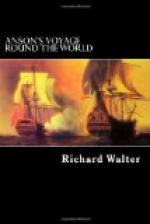To supply the place of the 240 invalids which had deserted there were ordered on board 210 marines detached from different regiments. These were raw and undisciplined men, for they were just raised, and had scarcely anything more of the soldier than their regimentals, none of them having been so far trained as to be permitted to fire. The last detachment of these marines came on board the 8th of August, and on the 10th the squadron sailed from Spithead to St. Helens, there to wait for a wind to proceed on the expedition.
But the diminishing the strength of the squadron was not the greatest inconvenience which attended these alterations, for the contests, representations, and difficulties which they continually produced occasioned a delay and waste of time which in its consequences was the source of all the disasters to which this enterprise was afterwards exposed. For by this means we were obliged to make our passage round Cape Horn in the most tempestuous season of the year, whence proceeded the separation of our squadron, the loss of numbers of our men, and the imminent hazard of our total destruction. And by this delay, too, the enemy had been so well informed of our designs that a person who had been employed in the South Sea Company’s* service, and arrived from Panama three or four days before we left Portsmouth, was able to relate to Mr. Anson most of the particulars of the destination and strength of our squadron from what he had learned among the Spaniards before he left them. And this was afterwards confirmed by a more extraordinary circumstance; for we shall find that when the Spaniards (fully satisfied that our expedition was intended for the South Seas) had fitted out a squadron to oppose us, which had so far got the start of us as to arrive before us off the island of Madeira, the Commander of this squadron was so well instructed in the form and make of Mr. Anson’s broad pennant, and had imitated it so exactly that he thereby decoyed the “Pearl”, one of our squadron, within gunshot of him before the captain of the Pearl was able to discover his mistake.
(Note. The South Sea Company was formed in 1711 on the model of the East India Company to trade in the Pacific; and on the conclusion of the Treaty of Utrecht it was given the monopoly of the English trade with the Spanish coasts of America. The grant of certain privileges by Government led to wild speculation in its shares which gave rise to the famous South Sea Bubble of 1720.)
On the 18th of September, 1740, the squadron weighed from St. Helens with a contrary wind. It consisted of five men-of-war, a sloop-of-war, and two victualling ships. They were the Centurion, of 60 guns, 400 men, George Anson, Esquire, commander; the “Gloucester”, of 50 guns, 300 men, Richard Norris, commander; the “Severn”, of 50 guns, 300 men, the Honourable Edward Legg, commander; the Pearl, of 40 guns, 250 men, Matthew Mitchel, commander; the “Wager”,




